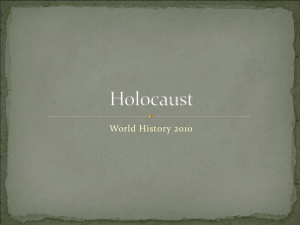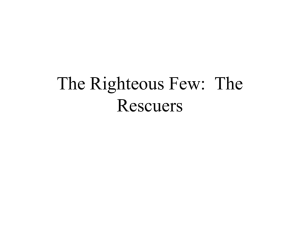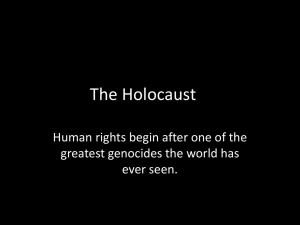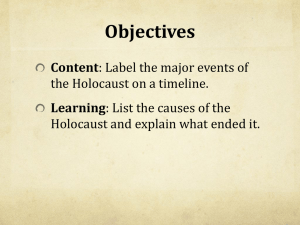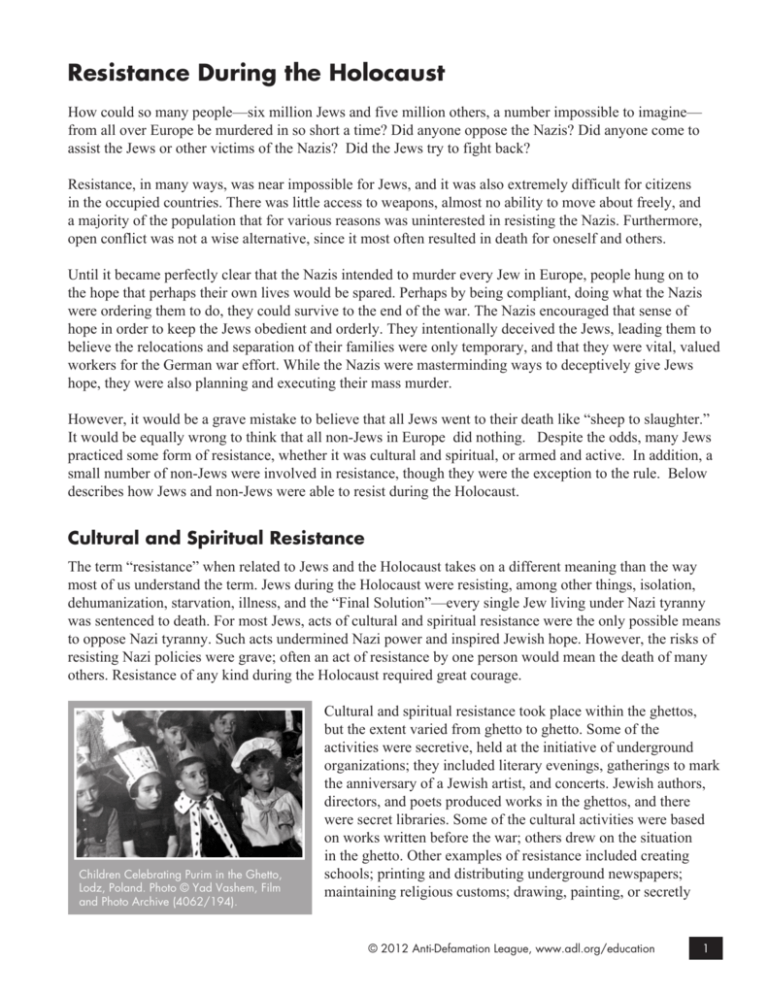
Resistance During the Holocaust
How could so many people—six million Jews and five million others, a number impossible to imagine—
from all over Europe be murdered in so short a time? Did anyone oppose the Nazis? Did anyone come to
assist the Jews or other victims of the Nazis? Did the Jews try to fight back?
Resistance, in many ways, was near impossible for Jews, and it was also extremely difficult for citizens
in the occupied countries. There was little access to weapons, almost no ability to move about freely, and
a majority of the population that for various reasons was uninterested in resisting the Nazis. Furthermore,
open conflict was not a wise alternative, since it most often resulted in death for oneself and others.
Until it became perfectly clear that the Nazis intended to murder every Jew in Europe, people hung on to
the hope that perhaps their own lives would be spared. Perhaps by being compliant, doing what the Nazis
were ordering them to do, they could survive to the end of the war. The Nazis encouraged that sense of
hope in order to keep the Jews obedient and orderly. They intentionally deceived the Jews, leading them to
believe the relocations and separation of their families were only temporary, and that they were vital, valued
workers for the German war effort. While the Nazis were masterminding ways to deceptively give Jews
hope, they were also planning and executing their mass murder.
However, it would be a grave mistake to believe that all Jews went to their death like “sheep to slaughter.”
It would be equally wrong to think that all non-Jews in Europe did nothing. Despite the odds, many Jews
practiced some form of resistance, whether it was cultural and spiritual, or armed and active. In addition, a
small number of non-Jews were involved in resistance, though they were the exception to the rule. Below
describes how Jews and non-Jews were able to resist during the Holocaust.
Cultural and Spiritual Resistance
The term “resistance” when related to Jews and the Holocaust takes on a different meaning than the way
most of us understand the term. Jews during the Holocaust were resisting, among other things, isolation,
dehumanization, starvation, illness, and the “Final Solution”—every single Jew living under Nazi tyranny
was sentenced to death. For most Jews, acts of cultural and spiritual resistance were the only possible means
to oppose Nazi tyranny. Such acts undermined Nazi power and inspired Jewish hope. However, the risks of
resisting Nazi policies were grave; often an act of resistance by one person would mean the death of many
others. Resistance of any kind during the Holocaust required great courage.
Children Celebrating Purim in the Ghetto,
Lodz, Poland. Photo © Yad Vashem, Film
and Photo Archive (4062/194).
Cultural and spiritual resistance took place within the ghettos,
but the extent varied from ghetto to ghetto. Some of the
activities were secretive, held at the initiative of underground
organizations; they included literary evenings, gatherings to mark
the anniversary of a Jewish artist, and concerts. Jewish authors,
directors, and poets produced works in the ghettos, and there
were secret libraries. Some of the cultural activities were based
on works written before the war; others drew on the situation
in the ghetto. Other examples of resistance included creating
schools; printing and distributing underground newspapers;
maintaining religious customs; drawing, painting, or secretly
© 2012 Anti-Defamation League, www.adl.org/education
1
photographing observed events; and keeping records of ghetto life and hiding them in the hope that they
would be discovered after the war. Such cultural activities helped people temporarily forget the worries of
ghetto life and were a source of encouragement. However, there was also criticism; some people argued that
these events were inappropriate in a place where so many people were dying every day.
In the camps, acts of cultural and spiritual resistance were more difficult but still occurred. Jews struggled
for humanity, for normalcy, and for life by purposefully attempting to keep themselves clean, not showing
emotion to their captures, helping others, organizing religious worship or by fasting on religious holidays
despite the fact that they were starving. Others worked below their capabilities and sometimes sabotaged
goods they were manufacturing. By making defective products to be used by the Nazis, the workers attained
personal satisfaction through the belief that they were stunting the German war effort. Though the actual
effects of this sabotage on the Nazi war effort cannot be measured, its effect on the morale of the workers
was strong.
Through cultural and spiritual resistance, Jews managed to create a personal–albeit tenuous–world in which
small, day-to-day decision-making mattered, as a way of preserving internal meaning.
Active/Armed Resistance in the Ghettos
In approximately one hundred ghettos, in Poland, Lithuania, Belorussia, and Ukraine, underground
organizations were formed. The purpose of such organizations was to wage armed struggle, that is, to
stage an uprising in the ghetto or to break out of the closed ghetto by the use of force in order to engage in
partisan operations on the outside. In many instances, the two forms combined, the uprising being followed
by an escape from the ghetto. There were also cases in which the uprising was spontaneous or improvised.
In many of the ghettos where resistance was more organized, Jewish youth movements were deeply
involved in the planning and carrying out of the plans. Active resistance occurred in many forms, from
armed struggle through hiding and escape.
While preparing for armed resistance, secret groups in the ghettos faced extremely difficult problems, such
as smuggling arms into the ghetto, training the fighters under ghetto conditions, and establishing a method
for putting the fighters on battle alert in case of a surprise action by the Germans. No less difficult was the
task of gaining the ghetto residents’ support for the fighting underground. It was clear that the insurgents did
not have the slightest chance of forcing the Germans to put a stop to the extermination, and it was equally
clear that only a handful of fighters could actually succeed in breaking out of the ghetto to join partisan units
in order to continue the fight against the Germans. This made the ghetto underground the only organization
of its kind in recorded history to call for an uprising whose primary purpose was to offer resistance for its
own sake.
The largest and most famous single revolt by Jews took place in the Warsaw Ghetto Uprising in April and
May of 1943, led by the Zydowska Organizacja Bojowa (Jewish Fighting Organization; Z.O.B). In the 27
days that the uprising officially lasted, the Nazis deployed a considerable military force that in the first days
of the fighting consisted, on the average, of 2,054 soldiers and policemen and 36 officers. Facing them were
700 to 750 young Jewish fighters who had no military training or battle experience, and who for all practical
purposes were armed with not much more than a few pistols. The hand-to-hand combat lasted for several
days. The Germans were not able to destroy the Jewish fighters, many of whom managed to get away and
retreat over the roofs after clashing with the Germans; nor could the Germans find the non-combatant Jews
hiding in the bunkers. The Germans decided to burn the ghetto systematically, house by house. This action
2
© 2012 Anti-Defamation League, www.adl.org/education
forced the fighters to take to the bunkers themselves and to resort to partisan tactics by staging sporadic
raids. The flames and the heat turned life in the bunkers into hell; the very air was afire, the goods that had
been stored spoiled, and the water was no longer fit to drink.
Gradually, the Jews’ ability to resist or hide declined. On May 8th, the headquarters of the Z.O.B. at 18 Mila
Street fell, and with it the commander of the uprising, Mordechai Anielewicz, and a large group of fighters
and officers. The Z.O.B. fighters had not made any plans for a retreat from the ghetto; their assumption was
that the battle would continue inside the ghetto until the last fighter had fallen. Thanks to a rescue mission
arranged by Z.O.B. men on the Polish side, several dozen fighters were saved by escaping from the ghetto
through the sewer system.
On May 16, German General Jurgen Stroop announced that the fighting was over. He blew up the Great
Synagogue on Tlomacka Street (which was outside the ghetto and the scene of the fighting) as a symbol of
victory and to declare to the world: “The Jewish quarter of Warsaw no longer exists.”
Armed/Active Resistance in the Extermination Camps
In several camps, notably Sobibór, Treblinka, and Auschwitz-Birkenau, Jewish workers whose forced labor
assignment was to dispose of (i.e., cremate) bodies of gas chamber victims (Sonderkommando) initiated
uprisings. All of these uprisings were brutally put down. In Birkenau all the rebels were killed, but in
Sobibór and Treblinka, a small number of prisoners managed to escape during the struggle. The Jewishinitiated uprisings in the camps were the only organized acts of armed resistance carried out against the
Nazis in the concentration and extermination camp network.
The revolt in Auschwitz-Birkenau attempted to put an end to the murder by disrupting the operation of
the crematoria, and also to create a memory and a testimony to the tragedy of the lives and deaths of the
hundreds of thousands of people who were killed there. After writing down and documenting the events,
one of the organizers of the Auschwitz-Birkenau revolt buried them near the crematoria.
Jews walk in a line towards the gas chambers. Auschwitz,
Poland, 1944. Photo courtesy of Yad Vashem.
“Dear finder, search every part of
the ground. Buried in it are dozens
of documents of others, and mine,
which shed light on everything that
happened here… As for us, we have
already lost all hope…
…The future will judge us on the
basis of this evidence. May the
world understand some small part of
the tragic world in which we lived.”
– Zalman Gradowski, September 6, 1944
© 2012 Anti-Defamation League, www.adl.org/education
3
Partisans
Partisan units are guerrilla fighters in occupied territories. During World War II, partisans risked their lives
by organizing secret resistance to Nazi control. They attacked German-held railroads, bridges, and military
installations. They also organized efforts to assassinate Nazi collaborators (local people who were helping
the Germans). During World War II, partisans in Nazi-occupied Europe were mainly active in Eastern
Europe. There was partisan activity in Yugoslavia, Poland, Greece, Slovakia, Belorussia, France, and Italy.
There were many crucial differences between Jewish and non-Jewish partisans. Non-Jewish partisans joined
the fight either as ultra-nationalists who wanted to rid their countries of all foreigners, or as socialist-leftists
who wanted to combat Fascism. They left their families at home, generally expecting to return to them after
the war. The Jewish partisans were not fighting for an ideal such as nationalism or anti-Fascism. The Jewish
partisans were fighting for their lives. Jewish partisans believed that they would never see home or family
again, especially since the Nazis had already murdered most of their families. Furthermore, non-Jewish
partisans had support, and believed that as patriotic citizens doing their duty for their country, they could
usually rely on local farmers to provide them with food and supplies. Not so the Jews. Jewish partisans
could rarely rely on the locals who often hated Jews.
In order to become a partisan, a Jew had to overcome all sorts of obstacles, grapple with emotional
dilemmas about abandoning family and community, and choose a life in the dangerous forest. Leaving
the ghetto was forbidden by the Germans, and usually if a person was caught he or she would be shot
on the spot. After a successful escape, he or she had to enter the forest and locate a partisan base whose
members might or might not have been willing to accept him or her. Despite all these obstacles, Jewish
partisan activity in Eastern Europe swelled to considerable proportions. Scholars believe that some 20,000–
30,000 Jews participated in the partisan units in the forests where they carried out daring raids and rescue
operations.
The East European forest was a natural place for Jews running from the Nazis to hide and regroup for
partisan activity. First, the territory was full of thick woodlands and many swamps, which provided ample
cover. Second, many of the Jews had lived in nearby areas before the war and were familiar with the terrain.
After the Germans launched mass murder campaigns in Belorussia and Ukraine during the second half of
1941, many Jews felt that their only choice was to flee to the forests. From that time on, Belorussia had the
largest concentration of partisans in Eastern Europe. By late August 1941, there were some 230 partisan
units in the region, with about 5,000 fighters (Jewish and non-Jewish). Just two years later, the numbers had
multiplied greatly, with 243,000 partisans in 1943 and 374,000 in 1944.
Rescuers Aiding Jews
While a relative few rescued Jews in Nazi-occupied Europe, the fact remains that some did, and they faced
enormous risks to save and care for those being persecuted. Rescuers helped friends, acquaintances and total
strangers. All faced the possibility of torture, deportation to concentration camps or execution by the Nazis,
with most attempts failing and resulting in the death of the Jews and sometime the rescuers themselves.
While no one will ever know about all the people who gave Jews food and water, temporary shelter in their
barns or a place to hide, we do know about the remarkable rescue operations of people like Oskar Schindler,
4
© 2012 Anti-Defamation League, www.adl.org/education
Raoul Wallenberg, and Chiune Sugihara who used their positions of
economic and/or political power to save thousands of Jews.
In addition to these individuals there were organized resistance efforts
and even entire nations that saved Jews. King Christian X and the
people of Denmark actively resisted the Nazis by refusing to identify
and turn over Danish Jews to the SS. Ninety five percent of Denmark’s
Jews survived the war. Another example is the 700 villagers and 2,000
peasants from the surrounding farms of Le Chambon-sur-Lignon,
a small Protestant village in France, who sheltered over 2,000 Jews
and other refugees from the Nazis. Belonging to a religious minority
themselves, the people of this small village could empathize with the
plight of those being persecuted.
Most rescuers deny doing anything heroic; rather, they believe they
only did what was right. Their stories represent the best of what we
recognize in the human spirit and give truth to the premise that “one
person can make a difference.”
Oskar Schindler
Conclusion
When thinking about resistance during the Holocaust one should not
dwell on how little or ineffectual it might appear to have been. Rather,
given the circumstances Jews and other targeted groups faced, it was
amazing that any act of defiance occurred at all.
These acts of resistance demonstrated the resolve of the Jewish people
and their allies who triumphed against all odds. Yet oftentimes given
the sheer enormity of this genocide these actions are overlooked or
viewed as being of secondary importance. This approach not only
trivializes the historical record but also dishonors the memory of those
who perished. Instead, it is important to remember the sacred duty that
the living must remember:
Raoul Wallenberg
“The still small voices of millions cry
out from the ground demanding that we
do no less.”
Chiune Sugihara
Portions of this section adapted from Echoes and Reflections — A Multimedia Curriculum on
the Holocaust (New York: Anti-Defamation League, USC Shoah Foundation Institute, Yad
Vashem, 2005). All rights reserved.
Photos courtesy of the United States
Holocaust Memorial Museum (USHMM)
© 2012 Anti-Defamation League, www.adl.org/education
5



